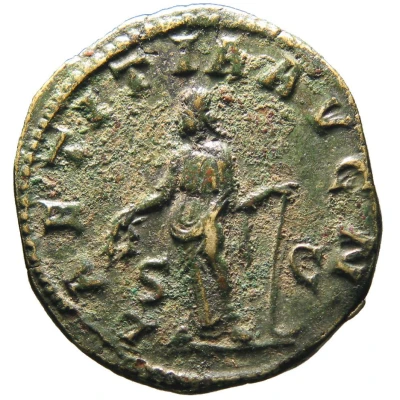Dupondius - Gordian III P M TR P V COS II P P S C; Apollo
| Bronze | - | - |
| Issuer | Rome › Roman Empire (27 BC - 395 AD) |
|---|---|
| Emperor | Gordian III (Marcus Antonius Gordianus) (238-244) |
| Type | Standard circulation coin |
| Years | 241-244 |
| Value | Dupondius (1⁄16) |
| Currency | Antoninianus, Reform of Caracalla (AD 215 – 301) |
| Composition | Bronze |
| Shape | Round (irregular) |
| Technique | Hammered |
| Demonetized | Yes |
| Updated | 2024-10-05 |
| Numista | N#281118 |
|---|---|
| Rarity index | 100% |
Reverse
Apollo, nude to waist, seated left, holding branch in extended right hand and resting left elbow on lyre.
Script: Latin
Lettering: P M TR P V COS II P P S C
Translation:
Pontifex Maximus, Tribunicia Potestate Quinta, Consul Secundum, Pater Patriae. Senatus Consultum.
High priest, holder of tribunician power for the fifth time, consul for the second time, father of the nation. Decree of the senate.
Comment
Source:Online Coins of the Roman Empire (OCRE)
Interesting fact
The Dupondius coin featuring Gordian III (P M TR P V COS II P P S C; Apollo) from the Roman Empire (27 BC - 395 AD) made of Bronze is interesting because it showcases the Roman Empire's use of currency as a means of propaganda. The coin's design features an image of Apollo, the Greek god of the sun, music, poetry, and prophecy, which was a common motif on Roman coins during this period. The inclusion of Apollo on the coin may have been intended to promote the idea of Roman imperial power and the association of the emperor with divine authority. Additionally, the coin's inscription, "P M TR P V COS II P P S C," which stands for "Pater Mundi, Tribunicia Potestate, Consul II, Pater Patriae, Senator," highlights Gordian III's titles and positions, further emphasizing his authority and legitimacy as a Roman emperor. Overall, this coin provides a fascinating glimpse into the political and cultural practices of the Roman Empire during the 3rd century AD.

